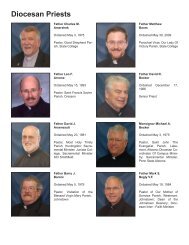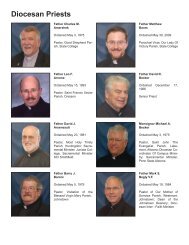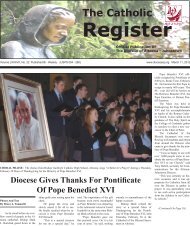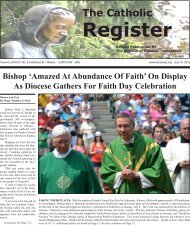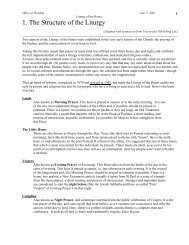encyclical letter deus caritas est of the supreme pontiff benedict xvi ...
encyclical letter deus caritas est of the supreme pontiff benedict xvi ...
encyclical letter deus caritas est of the supreme pontiff benedict xvi ...
You also want an ePaper? Increase the reach of your titles
YUMPU automatically turns print PDFs into web optimized ePapers that Google loves.
(Mt 25:36, 40). 36 Yet in <strong>the</strong> history <strong>of</strong> <strong>the</strong> Church, how many o<strong>the</strong>r t<strong>est</strong>imonies to charity could bequoted! In particular, <strong>the</strong> entire monastic movement, from its origins with Saint Anthony <strong>the</strong> Abbot(† 356), expresses an immense service <strong>of</strong> charity towards neighbour. In his encounter “face to face”with <strong>the</strong> God who is Love, <strong>the</strong> monk senses <strong>the</strong> impelling need to transform his whole life intoservice <strong>of</strong> neighbour, in addition to service <strong>of</strong> God. This explains <strong>the</strong> great emphasis on hospitality,refuge and care <strong>of</strong> <strong>the</strong> infirm in <strong>the</strong> vicinity <strong>of</strong> <strong>the</strong> monasteries. It also explains <strong>the</strong> immenseinitiatives <strong>of</strong> human welfare and Christianformation, aimed above all at <strong>the</strong> very poor, who became <strong>the</strong> object <strong>of</strong> care firstly for <strong>the</strong> monasticand mendicant orders, and later for <strong>the</strong> various male and female religious institutes all through <strong>the</strong>history <strong>of</strong> <strong>the</strong> Church. The figures <strong>of</strong> saints such as Francis <strong>of</strong> Assisi, Ignatius <strong>of</strong> Loyola, John <strong>of</strong>God, Camillus <strong>of</strong> Lellis, Vincent de Paul, Louise de Marillac, Giuseppe B. Cottolengo, John Bosco,Luigi Orione, Teresa <strong>of</strong> Calcutta to name but a few—stand out as lasting models <strong>of</strong> social charityfor all people <strong>of</strong> good will. The saints are <strong>the</strong> true bearers <strong>of</strong> light within history, for <strong>the</strong>y are menand women <strong>of</strong> faith, hope and love.41. Outstanding among <strong>the</strong> saints is Mary, Mo<strong>the</strong>r <strong>of</strong> <strong>the</strong> Lord and mirror <strong>of</strong> all holiness. In <strong>the</strong>Gospel <strong>of</strong> Luke we find her engaged in a service <strong>of</strong> charity to her cousin Elizabeth, with whom sheremained for “about three months” (1:56) so as to assist her in <strong>the</strong> final phase <strong>of</strong> her pregnancy.“Magnificat anima mea Dominum”, she says on <strong>the</strong> occasion <strong>of</strong> that visit, “My soul magnifies <strong>the</strong>Lord” (Lk 1:46). In <strong>the</strong>se words she expresses her whole programme <strong>of</strong> life: not setting herself at<strong>the</strong> centre, but leaving space for God, who is encountered both in prayer and in service <strong>of</strong>neighbour—only <strong>the</strong>n does goodness enter <strong>the</strong> world. Mary's greatness consists in <strong>the</strong> fact that shewants to magnify God, not herself. She is lowly: her only desire is to be <strong>the</strong> handmaid <strong>of</strong> <strong>the</strong> Lord(cf. Lk 1:38, 48). She knows that she will only contribute to <strong>the</strong> salvation <strong>of</strong> <strong>the</strong> world if, ra<strong>the</strong>r thancarrying out her own projects, she places herself completely at <strong>the</strong> disposal <strong>of</strong> God's initiatives.Mary is a woman <strong>of</strong> hope: only because she believes in God's promises and awaits <strong>the</strong> salvation <strong>of</strong>Israel, can <strong>the</strong> angel visit her and call her to <strong>the</strong> decisive service <strong>of</strong> <strong>the</strong>se promises. Mary is awoman <strong>of</strong> faith: “Blessed are you who believed”, Elizabeth says to her (cf. Lk 1:45). TheMagnificat—a portrait, so to speak, <strong>of</strong> her soul—is entirely woven from threads <strong>of</strong> Holy Scripture,threads drawn from <strong>the</strong> Word <strong>of</strong> God. Here we see how completely at home Mary is with <strong>the</strong> Word<strong>of</strong> God, with ease she moves in and out <strong>of</strong> it. She speaks and thinks with <strong>the</strong> Word <strong>of</strong> God; <strong>the</strong>Word <strong>of</strong> God becomes her word, and her word issues from <strong>the</strong> Word <strong>of</strong> God. Here we see how herthoughts are attuned to <strong>the</strong> thoughts <strong>of</strong> God, how her will is one with <strong>the</strong> will <strong>of</strong> God. Since Mary iscompletely imbued with <strong>the</strong> Word <strong>of</strong> God, she is able to become <strong>the</strong> Mo<strong>the</strong>r <strong>of</strong> <strong>the</strong> Word Incarnate.Finally, Mary is a woman who loves. How could it be o<strong>the</strong>rwise? As a believer who in faith thinkswith God's thoughts and wills with God's will, she cannot fail to be a woman who loves. We sensethis in her quiet g<strong>est</strong>ures, as recounted by <strong>the</strong> infancy narratives in <strong>the</strong> Gospel. We see it in <strong>the</strong>delicacy with which she recognizes <strong>the</strong> need <strong>of</strong> <strong>the</strong> spouses at Cana and makes it known to Jesus.We see it in <strong>the</strong> humility with which she recedes into <strong>the</strong> background during Jesus' public life,knowing that <strong>the</strong> Son must <strong>est</strong>ablish a new family and that <strong>the</strong> Mo<strong>the</strong>r's hour will come only with<strong>the</strong> Cross, which will be Jesus' true hour (cf. Jn 2:4; 13:1). When <strong>the</strong> disciples flee, Mary willremain beneath <strong>the</strong> Cross (cf. Jn 19:25-27); later, at <strong>the</strong> hour <strong>of</strong> Pentecost, it will be <strong>the</strong>y who ga<strong>the</strong>raround her as <strong>the</strong>y wait for <strong>the</strong> Holy Spirit (cf. Acts 1:14).42. The lives <strong>of</strong> <strong>the</strong> saints are not limited to <strong>the</strong>ir earthly biographies but also include <strong>the</strong>ir beingand working in God after death. In <strong>the</strong> saints one thing becomes clear: those who draw near to Goddo not withdraw from men, but ra<strong>the</strong>r become truly close to <strong>the</strong>m. In no one do we see this moreclearly than in Mary. The words addressed by <strong>the</strong> crucified Lord to his disciple—to John andthrough him to all disciples <strong>of</strong> Jesus: “Behold, your mo<strong>the</strong>r!” (Jn 19:27)—are fulfilled anew inevery generation. Mary has truly become <strong>the</strong> Mo<strong>the</strong>r <strong>of</strong> all believers. Men and women <strong>of</strong> every time




